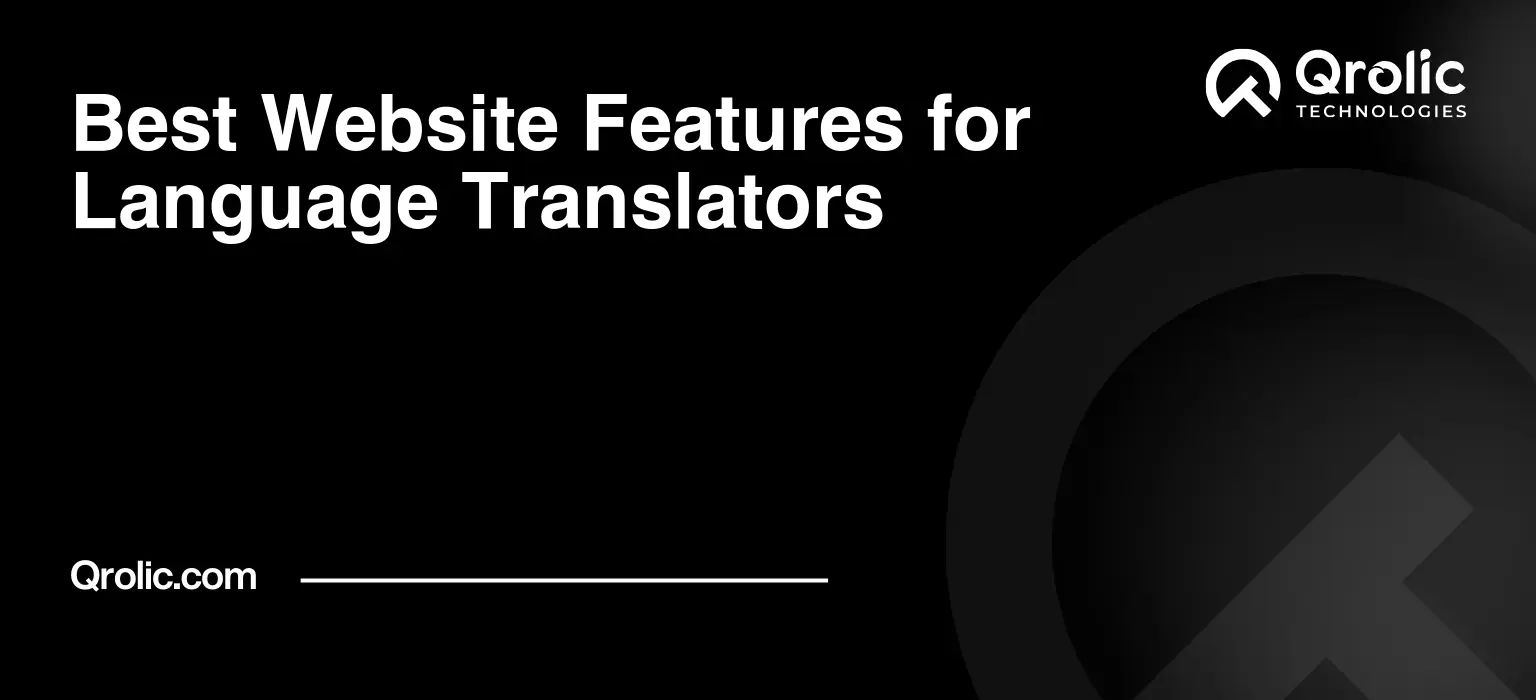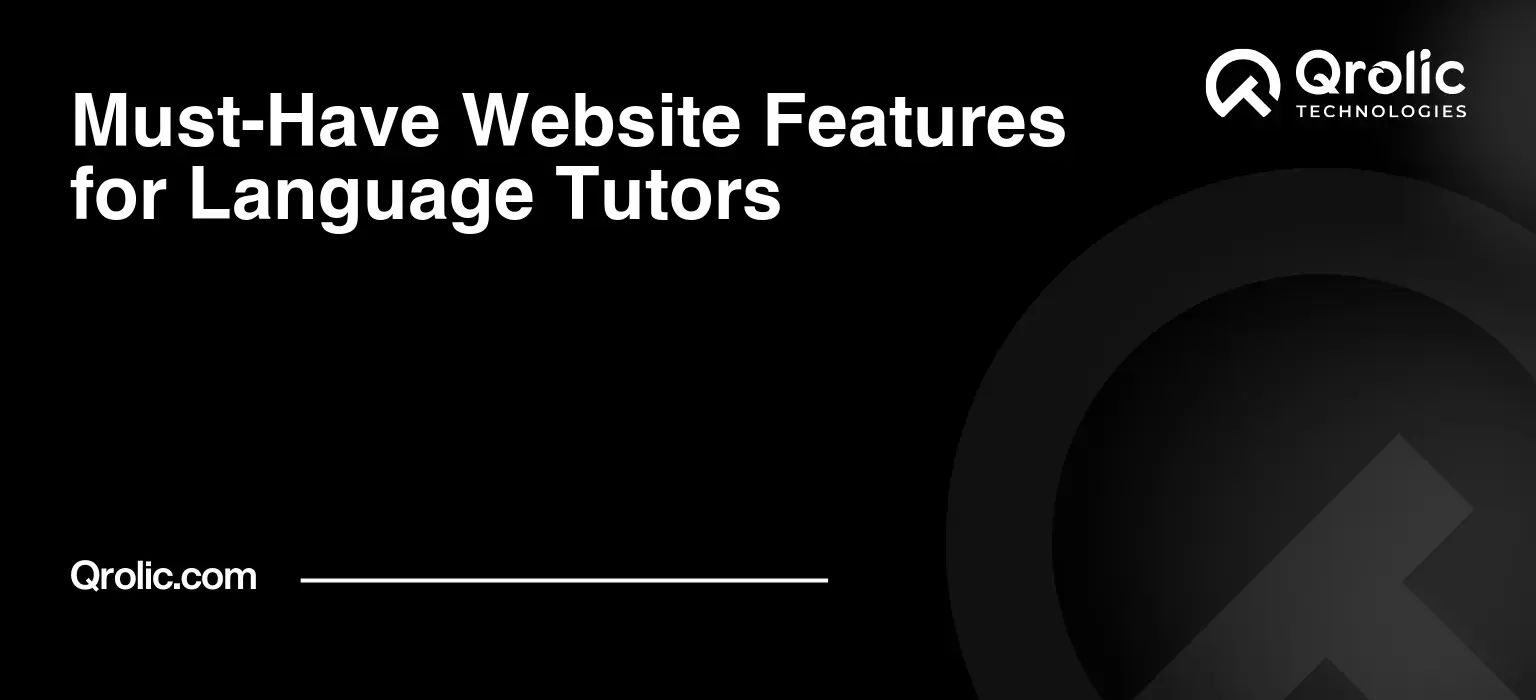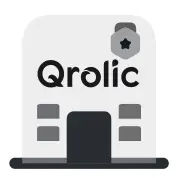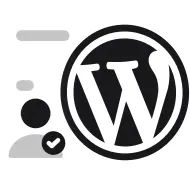Quick Summary:
- Make your website user-friendly and easy to navigate.
- Showcase expertise with quality, multilingual content.
- Simplify client process with online quotes and payments.
- Optimize for search and embrace new website tech.
Table of Contents
- The Foundation: A User-Centric Approach to Web Design for Language Services
- Understanding Your Target Audience: Speaking Their Language (Literally and Figuratively)
- Website Navigation: The Roadmap to Translation Success
- Responsive Design: Reaching Clients on Any Device
- Showcasing Your Expertise: Building Trust and Credibility
- High-Quality Content: The Language of Trust
- Multilingual Content: Practicing What You Preach
- Professional Design: Visual Appeal and Brand Identity
- Streamlining the Process: Making it Easy to Do Business
- Contact Form: The Gateway to Communication
- Multilingual Forms: Overcoming Language Barriers in Data Collection
- Online Quote Request System: Transparency and Efficiency
- Secure Payment Gateway: Building Confidence and Trust
- Enhancing SEO: Driving Traffic and Generating Leads
- Keyword Research: Understanding Search Intent
- On-Page Optimization: Making Your Website Search Engine Friendly
- Off-Page Optimization: Building Authority and Backlinks
- Tracking and Analysis: Measuring Success and Making Improvements
- Google Analytics: Understanding User Behavior
- A/B Testing: Optimizing for Conversions
- Qrolic Technologies: Your Partner in Language Solutions
- Staying Ahead of the Curve: Trends in Website Design for Language Translators
- Artificial Intelligence (AI) and Machine Learning (ML): Enhancing Efficiency and Accuracy
- Voice Search Optimization: Catering to the Growing Popularity of Voice Assistants
- Accessibility: Making Your Website Accessible to Everyone
The Foundation: A User-Centric Approach to Web Design for Language Services
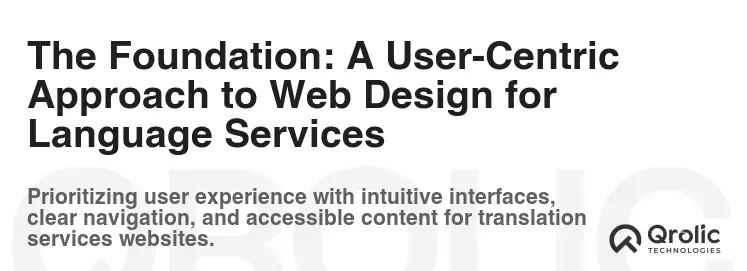
In the competitive landscape of language translation, your website is more than just a digital brochure; it’s your virtual storefront, your chief marketing officer, and often, the first (and only) impression potential clients have of your business. A truly effective website for language translators prioritizes the user experience (UX), ensuring that visitors find what they need quickly, easily, and enjoyably.
Understanding Your Target Audience: Speaking Their Language (Literally and Figuratively)
Before diving into specific features, it’s crucial to understand your target audience. Are you primarily serving businesses, individual clients, or both? What industries do they operate in? What languages are they translating to and from? Understanding these demographics and their specific needs will inform every design decision, from the color palette to the call to action.
Key Considerations for Audience Profiling:
- Industry Focus: Do you specialize in legal, medical, technical, or marketing translations? Tailor your content and examples accordingly.
- Language Pairs: Highlight your expertise in the most common language pairs you handle.
- Client Size: Are you targeting startups, SMEs, or large corporations? Different client sizes have different expectations and requirements.
- Technical Proficiency: Consider the technical skills of your target audience. A website geared towards tech-savvy clients can incorporate more complex features than one aimed at a less technical audience.
Website Navigation: The Roadmap to Translation Success
Intuitive navigation is paramount. Visitors should be able to find the information they need within seconds, not minutes.
Essential Navigation Elements:
- Clear and Concise Menu: Use simple, descriptive labels for menu items (e.g., “Services,” “About Us,” “Contact,” “Pricing,” “Blog”).
- Dropdown Menus (Use Judiciously): For extensive service offerings, dropdown menus can organize information effectively, but avoid overwhelming users with too many options.
- Search Bar: A prominent search bar allows users to quickly locate specific information or services.
- Breadcrumbs: Breadcrumbs help users understand their location within the website and easily navigate back to previous pages.
- Footer Navigation: Include important links in the footer, such as “Terms of Service,” “Privacy Policy,” “Sitemap,” and “Contact Us.”
Responsive Design: Reaching Clients on Any Device
In today’s mobile-first world, a responsive website is non-negotiable. Your website must adapt seamlessly to different screen sizes and devices, providing an optimal viewing experience on desktops, laptops, tablets, and smartphones.
Benefits of Responsive Design:
- Improved User Experience: Ensures a consistent and enjoyable experience across all devices.
- Enhanced SEO: Google prioritizes mobile-friendly websites in its search rankings.
- Increased Conversions: A mobile-friendly website makes it easier for users to contact you and request a quote.
- Reduced Bounce Rate: Visitors are less likely to leave your website if it’s easy to navigate on their device.
Showcasing Your Expertise: Building Trust and Credibility

Translators are trusted with delicate and important documents. Your website needs to instantly show visitors that you are capable, trustworthy, and qualified to handle their translation needs.
High-Quality Content: The Language of Trust
Your website’s content is your most valuable asset. It should be well-written, informative, accurate, and tailored to your target audience. Avoid jargon and technical terms that may confuse visitors.
Key Content Elements:
- Clear Value Proposition: Communicate the benefits of your services in a clear and concise manner. What problems do you solve? What value do you provide?
- Service Descriptions: Provide detailed descriptions of your translation services, including the types of documents you translate, the language pairs you offer, and any specialized areas of expertise.
- About Us Page: Tell your story! Introduce your team, highlight your experience, and showcase your commitment to quality.
- Case Studies: Showcase successful translation projects you’ve completed. Highlight the challenges you faced, the solutions you provided, and the results you achieved.
- Testimonials: Feature testimonials from satisfied clients. Social proof can significantly boost your credibility.
- Blog: Create a blog to share your expertise, discuss industry trends, and provide valuable information to your target audience.
Multilingual Content: Practicing What You Preach
If you offer translation services, your website should be multilingual. Offer visitors the option to view your website in multiple languages. This demonstrates your commitment to multilingualism and makes your website accessible to a wider audience.
Implementing Multilingual Content:
- Language Switcher: Provide a prominent language switcher that allows users to easily select their preferred language.
- Professional Translation: Ensure that all translated content is accurate and culturally appropriate. Use professional translators to avoid embarrassing errors.
- SEO Considerations: Implement proper SEO strategies for each language version of your website. Use hreflang tags to indicate the language and region of each page.
Professional Design: Visual Appeal and Brand Identity
A visually appealing website is essential for making a positive first impression. Invest in a professional design that reflects your brand identity and conveys a sense of professionalism and trustworthiness.
Key Design Elements:
- Clean and Modern Design: Avoid clutter and distractions. Use a clean and modern design that is easy on the eyes.
- High-Quality Images: Use high-quality images that are relevant to your services and target audience.
- Consistent Branding: Use consistent branding throughout your website, including your logo, color palette, and typography.
- Mobile-Friendly Design: As mentioned earlier, ensure that your website is responsive and adapts seamlessly to different screen sizes.
Streamlining the Process: Making it Easy to Do Business
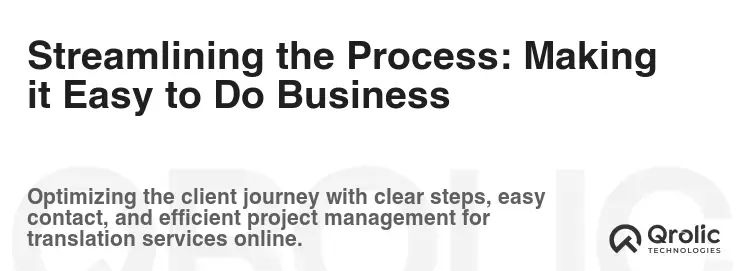
A well-designed website should make it easy for potential clients to request a quote, place an order, and communicate with you.
Contact Form: The Gateway to Communication
A well-designed contact form is essential for capturing leads and providing excellent customer service.
Key Contact Form Elements:
- Required Fields: Only require essential information, such as name, email address, and message.
- Clear Instructions: Provide clear instructions on how to complete the form.
- File Upload: Allow users to upload documents for translation.
- Captcha: Implement a captcha to prevent spam submissions.
- Confirmation Message: Display a confirmation message after the form has been submitted.
Multilingual Forms: Overcoming Language Barriers in Data Collection
Offering multilingual forms is crucial for catering to a global clientele and ensuring seamless communication. This feature allows clients to submit requests, inquiries, and project details in their preferred language, eliminating potential misunderstandings and enhancing the user experience.
Benefits of Multilingual Forms:
- Improved Accuracy: Clients can express their needs precisely in their native language, reducing the risk of errors in translation projects.
- Increased Accessibility: Broadens your reach to a wider audience who may not be comfortable communicating in English or other common business languages.
- Enhanced Customer Satisfaction: Demonstrates your commitment to inclusivity and personalized service, fostering stronger client relationships.
Implementation Strategies for Multilingual Forms:
- Dynamic Translation: Utilize a form builder that supports dynamic translation, allowing you to create a single form template and automatically translate it into multiple languages.
- Language Selection: Provide a clear and prominent language selection menu within the form, enabling users to choose their preferred language.
- Professional Translation Review: Ensure that all translated form fields are reviewed by a professional translator to guarantee accuracy and cultural appropriateness.
- Database Integration: Integrate your multilingual forms with your database to store and manage client data in multiple languages efficiently.
Online Quote Request System: Transparency and Efficiency
An online quote request system allows potential clients to quickly and easily request a quote for their translation project.
Key Features of an Online Quote Request System:
- Document Upload: Allow users to upload documents for translation.
- Language Pair Selection: Provide a list of available language pairs.
- Subject Matter Specialization: Allow users to specify the subject matter of their document.
- Turnaround Time: Allow users to select their desired turnaround time.
- Word Count Calculation: Automatically calculate the word count of the document.
- Instant Quote (Optional): Provide an instant quote based on the information provided.
Secure Payment Gateway: Building Confidence and Trust
A secure payment gateway is essential for processing online payments safely and securely.
Key Features of a Secure Payment Gateway:
- SSL Encryption: Ensure that all data transmitted between the user’s browser and your server is encrypted using SSL.
- PCI Compliance: Comply with the Payment Card Industry Data Security Standard (PCI DSS).
- Multiple Payment Options: Offer a variety of payment options, such as credit cards, debit cards, and PayPal.
- Fraud Prevention: Implement fraud prevention measures to protect against fraudulent transactions.
Enhancing SEO: Driving Traffic and Generating Leads
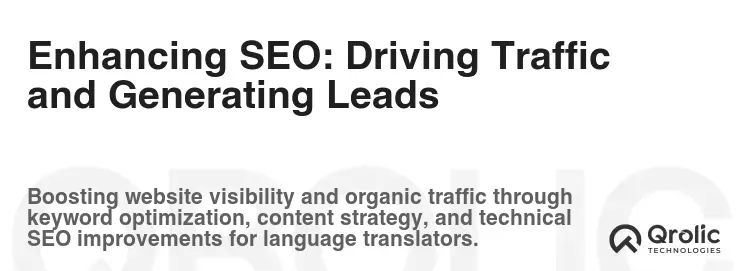
A well-optimized website is essential for attracting organic traffic from search engines.
Keyword Research: Understanding Search Intent
Conduct thorough keyword research to identify the keywords that your target audience is using to search for translation services.
Keyword Research Tools:
- Google Keyword Planner: A free tool from Google that provides keyword suggestions and search volume data.
- SEMrush: A comprehensive SEO tool that provides keyword research, competitor analysis, and website auditing features.
- Ahrefs: Another popular SEO tool that offers similar features to SEMrush.
On-Page Optimization: Making Your Website Search Engine Friendly
Optimize your website’s content and structure to improve its search engine rankings.
On-Page Optimization Techniques:
- Title Tags: Use keyword-rich title tags for each page on your website.
- Meta Descriptions: Write compelling meta descriptions that encourage users to click on your website in search results.
- Header Tags: Use header tags (H1, H2, H3, etc.) to structure your content and highlight important keywords.
- Image Alt Text: Add descriptive alt text to all images on your website.
- Internal Linking: Link to relevant pages within your website.
- URL Structure: Use keyword-rich URLs.
Off-Page Optimization: Building Authority and Backlinks
Build authority and backlinks to your website from other reputable websites.
Off-Page Optimization Techniques:
- Guest Blogging: Write guest posts for other websites in your industry and include a link back to your website.
- Directory Submissions: Submit your website to relevant online directories.
- Social Media Marketing: Promote your website on social media.
- Link Building: Reach out to other websites and request a link back to your website.
Tracking and Analysis: Measuring Success and Making Improvements
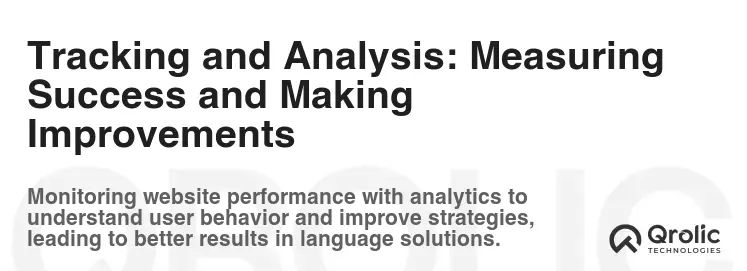
Use analytics tools to track your website’s performance and identify areas for improvement.
Google Analytics: Understanding User Behavior
Google Analytics is a free tool that provides detailed information about your website’s traffic, including the number of visitors, the pages they visit, and the time they spend on your website.
Key Metrics to Track:
- Traffic: The number of visitors to your website.
- Bounce Rate: The percentage of visitors who leave your website after viewing only one page.
- Conversion Rate: The percentage of visitors who complete a desired action, such as requesting a quote or placing an order.
- Keyword Rankings: The position of your website in search results for specific keywords.
A/B Testing: Optimizing for Conversions
A/B testing allows you to compare different versions of your website to see which one performs better.
Examples of A/B Tests:
- Headline Testing: Test different headlines to see which one attracts more clicks.
- Call to Action Testing: Test different call to action buttons to see which one generates more leads.
- Layout Testing: Test different website layouts to see which one improves the user experience.
Qrolic Technologies: Your Partner in Language Solutions
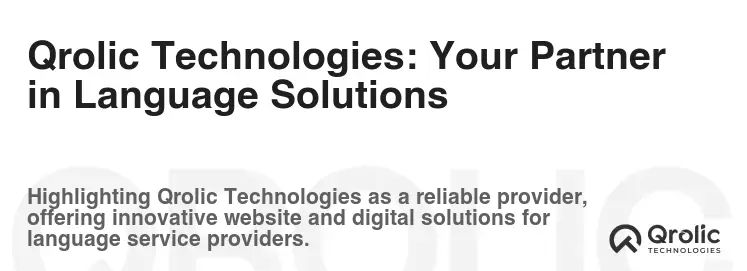
At Qrolic Technologies (https://qrolic.com/), we understand the complexities of the language industry and the importance of effective communication. We offer a comprehensive suite of language solutions tailored to meet your specific needs, from translation and localization to interpretation and content creation.
Why Choose Qrolic Technologies?
- Expert Translators: We work with a global network of experienced and qualified translators who are native speakers of the target language.
- Quality Assurance: We have a rigorous quality assurance process to ensure that all translations are accurate, culturally appropriate, and meet our high standards.
- Cutting-Edge Technology: We leverage the latest translation technology to improve efficiency and accuracy.
- Dedicated Project Management: We provide dedicated project management to ensure that your project is completed on time and within budget.
- Customized Solutions: We offer customized language solutions to meet your specific needs and requirements.
Whether you need a website translated, documents localized, or an interpreter for your next meeting, Qrolic Technologies is your trusted partner in language solutions. Contact us today to learn more about our services and how we can help you succeed in the global marketplace.
Staying Ahead of the Curve: Trends in Website Design for Language Translators
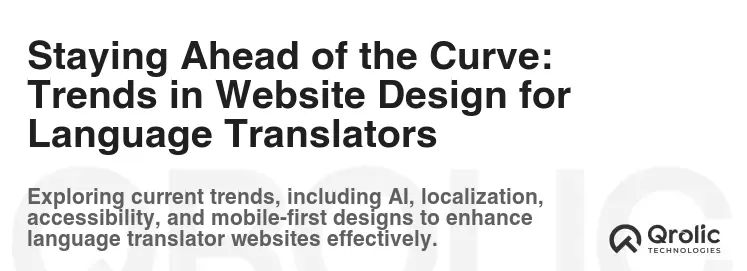
The digital landscape is constantly evolving, and it’s crucial to stay abreast of the latest trends in website design to maintain a competitive edge.
Artificial Intelligence (AI) and Machine Learning (ML): Enhancing Efficiency and Accuracy
AI and ML are transforming the language industry, offering opportunities to automate tasks, improve accuracy, and personalize the user experience.
Applications of AI and ML in Website Design for Language Translators:
- Automated Translation: AI-powered translation tools can provide instant translations of website content.
- Machine Translation Post-Editing (MTPE): MTPE involves using human translators to review and edit machine-translated content, improving accuracy and fluency.
- Personalized Content: AI can be used to personalize website content based on user preferences and demographics.
- Chatbots: AI-powered chatbots can provide instant customer support in multiple languages.
Voice Search Optimization: Catering to the Growing Popularity of Voice Assistants
Voice search is becoming increasingly popular, and it’s important to optimize your website for voice search queries.
Voice Search Optimization Techniques:
- Long-Tail Keywords: Focus on long-tail keywords that are commonly used in voice searches.
- Conversational Language: Use conversational language in your website content.
- Schema Markup: Use schema markup to provide search engines with more information about your website content.
- Mobile-Friendliness: Ensure that your website is mobile-friendly.
Accessibility: Making Your Website Accessible to Everyone
Accessibility is essential for ensuring that your website is accessible to people with disabilities.
Accessibility Guidelines:
- Web Content Accessibility Guidelines (WCAG): Follow the WCAG guidelines to make your website more accessible.
- Alternative Text: Provide alternative text for all images on your website.
- Keyboard Navigation: Ensure that your website can be navigated using a keyboard.
- Color Contrast: Use sufficient color contrast between text and background.
- Captions and Transcripts: Provide captions and transcripts for all videos and audio content.
By incorporating these features and staying up-to-date with the latest trends, you can create a website that not only attracts visitors but also converts them into loyal clients. Remember, your website is your virtual storefront, so make it inviting, informative, and easy to navigate. This investment will pay dividends in increased traffic, leads, and ultimately, business success.
